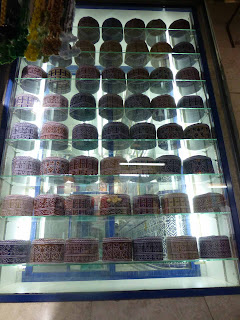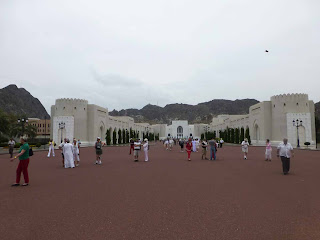April 26, Friday. We have left the emirates behind and are now in Oman for a couple of days. Today our stop is Muscat. Is it any different from the Emirates? To my surprise it is. The most obvious difference was our tour guide. Where our last several guides have been non locals, here all the guides and even the bus drivers are local citizens, as are most of the shop owners. We can spot them by their traditional dress--a full length white kandura almost always worn with an embroidered cap.
They do receive many of the typical benefits of this region, but Oman is trying to keep the bulk of its less menial jobs for Omanis. Our guide is a 23 year old college student who is majoring in tourism and hoping to complete his masters in Germany next year after being foiled by the complexities of French. (I sympathize!) He is the youngest of fourteen children by two mothers, all of whom forbade his father from taking a third wife recently. Most of his siblings, even the girls, are educated. Here women can drive, go to school, have careers, decide how to dress although most choose the protection of the abaya, and even whether, when, and whom to marry. This has been more or less true in all the Arab countries we have visited, and I think that has been the biggest eye opener for me. I have thought all Arab women were oppressed to at least some degree, but it seems aspects of their lifestyle are a much more comfortable choice for them than I guessed. When you see local women in the shops of the souk, they are often unaccompanied, seem very happy, are often beautifully dressed even in their abayas, much less whatever splendid clothing lies beneath, and generally seem very well cared for. The children are happy and open as well. Girls begin to wear the abaya when they become women, at about 14, or whenever they and their families agree they should. It is probably an honored rite of passage and not the oppressive retreat into purdah that we think of so negatively. That said, between 5000 and 20,000 women are killed around the world in Muslim "honor" killings each year, so don't imagine oppression does not exist. We are often told that the interior areas of these countries are far more conservative than coastal regions where foreigners are courted and catered to for their tourist dollars. Oman's choice to employ dramatically fewer foreign workers was made because they hope to attract foreign money but not dilute their culture as much as they fear their neighbors have done. The result is that here we see and interact with many more local citizens, making this entire country seem much more authentic than the Disney-like perfection of the arab countries we visited previous to Oman.
 |
| Our local guide, kandura, cap, and all |
Our tour was another bus ride around the sites, including the local historical site.
 |
| Ornate decoration is typical throughout the Arab world. Everything, from doors to interior and exterior walls is elaborately decorated. |
 |
| And so is clothing, from jewelry to dress to men's caps |
We had an extended stop at the Zawawi Mosque. We could not enter, but the exterior was quite nice.
 |
| Zawawi Mosque |
 |
| Our guide at the mosque |
 |
| Calligraphy is a high art form in this region |
Near the mosque we saw a reminder of daily life, and one of government bureaucracy.
 |
| Shops and a bakery, common sights |
 |
| The ministry of education |
We stopped at the small, private Bait Adam museum, but they didn't allow much photography, and the display wasn't all that interesting. The most interesting part of this museum was the daughter of the family. She was about 8 or 10 and could spout out answers to all sorts of questions about US history and government. She was clearly well schooled and has an excellent memory, but I'm not sure she understood much if any of the words she recited. One man in our tour group had been here three years ago and remembered the same performance.
Our next stop was the souk, this one specializing in local trinkets and incense.
 |
| The entrance, with a busy silver shop |
 |
| Looking up |
 |
| A welcome mural |
 |
| Fabrics, fabrics again! |
 |
| This may be hard to see, but it is a display of the embroidered caps the men wear |
 |
| The hub of the souk |
 |
| Always busy with locals, expats, and tourists alike |
We drove through Muscat and up a hill where we had a good view of the city.
 |
| In addition to the town, you can see the old fortifications in the distance |
Our last stop was the splendid Al Alam Palace built by Sultan Qaboos to impress visiting heads of state. It apparently contains only a banquet hall and meeting rooms, but has never been a royal residence.
 |
| A new wall at Al Alam and an old defense tower in the distance |
 |
| This place is huge, considering its limited purpose. |
 |
| Click on this to see the local people at the guard tower. I think this may be a new one, or at least it has been refurbished for use guarding this site. |
 |
| The gardens are beautiful |
 |
| Flowers and security |
 |
| I think this is the banquet hall |
 |
| The long promenade |
We were at the palace when it was time for the noon call to prayer, and of course there was a mosque nearby.
It was the first time we have heard that except once or twice off in the distance. This time we were surrounded by the wailing broadcast, which was very loud and went on for a much longer time than I expected. We have been told that the language, the intonations, and the very "tune" of these chants can vary widely from mosque to mosque and country to country, but the exact words of the call do not change. Here is what is sung, in Arabic and English.
Allahu Akbar
God is Great
(said four times)
God is Great
(said four times)
Ashhadu an la ilaha illa Allah
I bear witness that there is no god except the One God.
(said two times)
I bear witness that there is no god except the One God.
(said two times)
Ashadu anna Muhammadan Rasool Allah
I bear witness that Muhammad is the messenger of God.
(said two times)
I bear witness that Muhammad is the messenger of God.
(said two times)
Hayya 'ala-s-Salah
Hurry to the prayer (Rise up for prayer)
(said two times)
Hurry to the prayer (Rise up for prayer)
(said two times)
Hayya 'ala-l-Falah
Hurry to success (Rise up for Salvation)
(said two times)
Hurry to success (Rise up for Salvation)
(said two times)
Allahu Akbar
God is Great
[said two times]
God is Great
[said two times]
La ilaha illa Allah
There is no god except the One God
There is no god except the One God
For the pre-dawn (fajr) prayer, the following phrase is inserted after the fifth part above, towards the end:
As-salatu Khayrun Minan-nawm
Prayer is better than sleep
(said two times)
Prayer is better than sleep
(said two times)
On our way back to the boat, we were able to get a nice view of it across the harbor.
 |
| The Regent Seven Seas Voyager |
 |
| A local dhow |
Along the corniche, we saw a dome and a dolphin that seemed worthy of attention as well.
It rained as we were leaving port this evening. How strange and unexpected, but it has been overcast often in the last few days so not entirely unexpected. John says the mountains caused it, but the land all around was so very dry. How could that be?













No comments:
Post a Comment